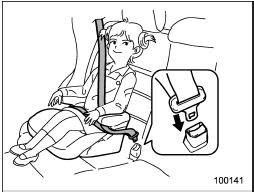Installing a booster seat

• Child restraint systems and seatbelts can become hot in a vehicle that has been closed up in sunny weather; they could burn a small child. Check the child restraint system before you place a child in it.
• Do not leave an unsecured child restraint system in your vehicle.
Unsecured child restraint systems can be thrown around inside of the vehicle in a sudden stop, turn or accident; they can strike and injure vehicle occupants as well as result in serious injuries or death to the child.

When you install a child restraint system, follow the manufacturer’s instructions supplied with it. After installing the child restraint system, check to ensure that it is held securely in position. If it is not held tight and secure, the danger of your child suffering personal injury in the event of an accident may be increased.

1. Place the booster seat in the rear seating position and sit the child on it. The child should sit well back on the booster seat.
2. Run the lap and shoulder belt through or around the booster seat and the child following the instructions provided by its manufacturer.
3. Insert the tongue plate into the buckle until you hear a click. Take care not to twist the seatbelt.
Make sure the shoulder belt is positioned across the center of child’s shoulder and that the lap belt is positioned as low as possible on the child’s hips.

4. To remove the booster seat, press the release button on the seatbelt buckle and allow the belt to retract.

• Never use a belt that is twisted or reversed. In an accident, this can increase the risk or severity of injury to the child.
• Never place the shoulder belt under the child’s arm or behind the child’s back. If an accident occurs, this can increase the risk or severity of injury to the child.
• The seatbelt should fit snugly in order to provide full restraint.
Loose fitting belts are not as effective in preventing or reducing injury.
• Place the lap belt as low as possible on the child’s hips. A high-positioned lap belt will increase the risk of sliding under the lap belt and of the lap belt sliding up over the abdomen, and both can result in serious internal injury or death.
• Make sure the shoulder belt is positioned across the center of child’s shoulder. Placing the shoulder belt over the neck may result in neck injury during sudden braking or in a collision.
See also:
Operation
If the driver and/or front passenger have/ has not yet fastened the seatbelt(s)
when the ignition switch is turned to the “ON” position, the seatbelt warning light(s)
will flash for 6 seconds, to ...
Recommended spark plugs
For the recommended spark plugs, refer to “Electrical system”. ...
AT models
1. Apply the parking brake.
2. Turn off unnecessary lights and accessories.
3. Shift the select lever to the “P” or “N”
position (preferably “P” position).
The starter motor will only operate whe ...


